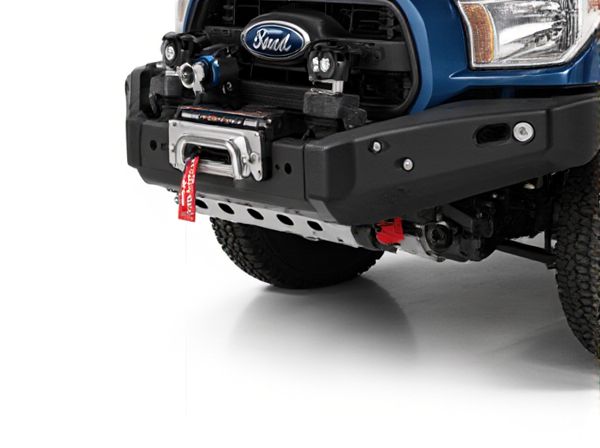
Photo illustration: Winch bumper vs Non-winch bumper
Winch bumpers provide enhanced utility by allowing you to mount a winch for vehicle recovery and off-road assistance, making them essential for adventurous drivers. Non-winch bumpers offer a lighter, more streamlined design focused on aesthetics and basic protection, suitable for everyday driving and urban use. Choosing between the two depends on your specific needs for functionality versus style and weight.
Table of Comparison
| Feature | Winch Bumper | Non-Winch Bumper |
|---|---|---|
| Winch Compatibility | Integrated mount for winch | No winch mount available |
| Vehicle Recovery | Enables self-recovery and pulling | Limited or no recovery capability |
| Durability | Heavy-duty steel construction | Varies, often lighter material |
| Weight | Heavier, adds to vehicle mass | Lighter, improves fuel efficiency |
| Cost | Higher due to winch features | Lower cost option |
| Installation Complexity | Requires professional installation | Easier DIY installation |
| Off-Road Use | Best suited for off-road recovery | Basic protection, less off-road utility |
Introduction to Winch and Non-Winch Bumpers
Winch bumpers are designed with integrated mounts to securely hold a winch, providing essential recovery capabilities for off-road vehicles. Non-winch bumpers prioritize lightweight protection and aesthetic appeal without accommodating winch installation. Choosing between winch and non-winch bumpers depends on vehicle recovery needs, with winch bumpers offering enhanced functionality for rugged terrains and non-winch bumpers suited for everyday driving and lighter impact protection.
Key Differences Between Winch and Non-Winch Bumpers
Winch bumpers are designed to accommodate winch mounts, offering enhanced vehicle recovery capabilities, while non-winch bumpers lack this structure and focus solely on protection and aesthetics. Winch bumpers are typically heavier, made with reinforced steel to handle winch stress, whereas non-winch bumpers are lighter and may prioritize style or basic impact resistance. The key differences lie in functionality, weight, and mounting options, making winch bumpers essential for off-road enthusiasts requiring vehicle self-recovery solutions.
Benefits of Choosing a Winch Bumper
Winch bumpers provide enhanced recovery capabilities by allowing users to easily attach and operate winches, essential for off-road vehicle self-recovery in difficult terrain. They offer superior strength and durability with reinforced steel construction, protecting the vehicle's front end from impacts and obstacles. Additionally, winch bumpers improve functionality by integrating mounting points for auxiliary lights and tow hooks, increasing versatility in outdoor and emergency situations.
Advantages of Non-Winch Bumpers
Non-winch bumpers offer advantages such as reduced vehicle weight, improving fuel efficiency and handling by minimizing front-end mass. They provide simpler installation and lower maintenance costs due to the absence of winch components and associated wiring. Enhanced ground clearance and approach angles also make non-winch bumpers ideal for off-road use where obstacles and terrain demand maximum maneuverability.
Vehicle Compatibility Considerations
Winch bumpers require specific vehicle compatibility to accommodate the additional weight and mounting hardware, often necessitating reinforced frames or models designed with winch integration points. Non-winch bumpers offer broader compatibility as they lack the structural demands for winch support, making them suitable for a wider range of vehicles without modifications. Evaluating OEM specifications and aftermarket options ensures proper fitment and maintains vehicle safety and performance.
Off-Road Performance Comparison
Winch bumpers enhance off-road performance by providing a robust mounting point for a winch, enabling self-recovery in difficult terrains such as mud, sand, or rocky paths. Non-winch bumpers typically offer lighter weight and improved approach angles, which can benefit maneuverability but lack the critical utility and durability required for extreme off-road recovery situations. Off-road enthusiasts prioritize winch bumpers for their durability, integrated recovery points, and ability to handle heavy loads during winching, critical for overcoming challenging obstacles.
Installation and Maintenance Factors
Winch bumpers typically require more complex installation due to the need for mounting the winch securely and wiring it into the vehicle's electrical system, which may necessitate professional assistance. Maintenance of winch bumpers involves regular inspection of the winch cables, motor, and electrical connections to ensure reliable operation under load, whereas non-winch bumpers generally demand less frequent upkeep focused mainly on surface protection and structural integrity. The added weight and integration complexity of winch bumpers also influence vehicle dynamics and may impact long-term wear on mounting points compared to simpler non-winch alternatives.
Cost Comparison: Winch Bumper vs Non-Winch Bumper
Winch bumpers typically cost between $600 and $1,500, depending on materials and brand, while non-winch bumpers are generally priced lower, ranging from $200 to $800. Installation expenses for winch bumpers can add $100 to $300 due to the complexity of mounting a winch and wiring, whereas non-winch bumpers often require less labor and cost. Investing in a winch bumper provides added functionality for off-roading and recovery situations, but non-winch bumpers offer a more budget-friendly option for basic protection and styling.
Aesthetics and Customization Options
Winch bumpers offer enhanced rugged aesthetics with integrated mounting points for winches, providing a bold and functional front-end appearance ideal for off-road enthusiasts. Non-winch bumpers typically feature sleek, minimalist designs that prioritize a clean look and lighter weight, appealing to those focused on urban or light-use styling. Customization options for winch bumpers often include additional tow hooks, LED light mounts, and reinforced steel construction, while non-winch bumpers allow for smoother finishes and paint-matching to complement vehicle aesthetics.
Which Bumper Is Best for Your Needs?
Winch bumpers provide enhanced recovery options and heavy-duty protection, ideal for off-road enthusiasts facing challenging terrains or frequent vehicle self-recovery situations. Non-winch bumpers offer lighter protection, better fuel efficiency, and easier installation, suitable for urban drivers or those who rarely require vehicle recovery tools. Choosing the best bumper depends on evaluating your driving conditions, recovery needs, and vehicle compatibility to ensure maximum functionality and durability.
 caratoz.com
caratoz.com